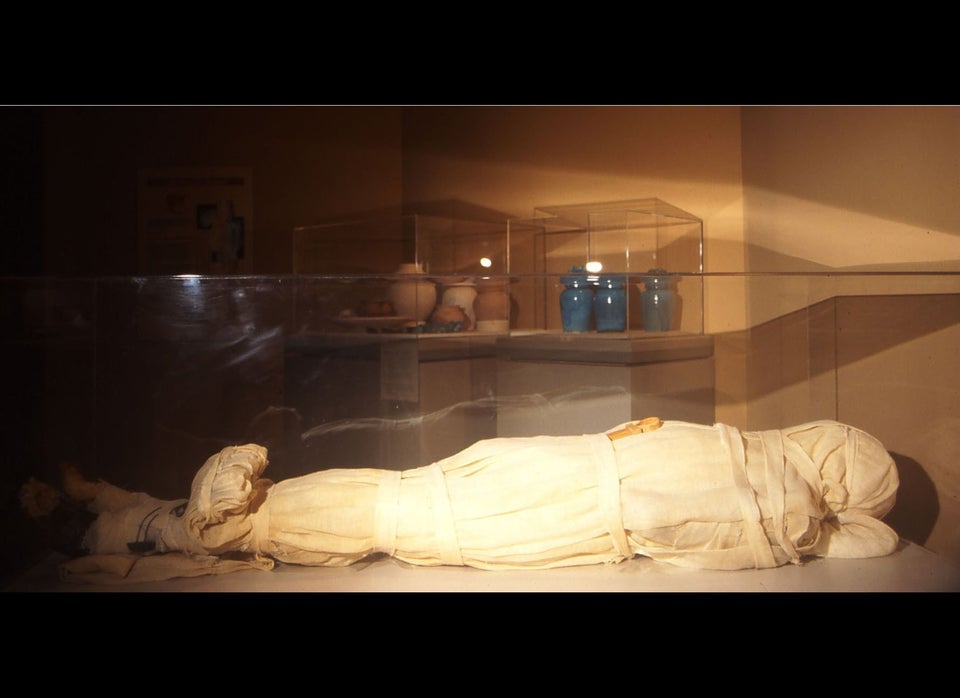
As far as pop culture interest goes, it's hard to beat the massive zombie onslaught.
However, mummies may be taking them over for at least this week.
In a strange convergence, there are three major mummy events scheduled over the next week, giving mummies their highest profile since Brendan Fraser's last "Mummy" sequel.
The events include a new exhibit at the San Diego Museum of Man opening June 10 that features the mummy of a man in his 70s, who, in 1994, was mummified by scientists using the ancient Egyptian methods.
(Story continued below)
And Philadelphia is becoming "The City of Mummerly Love" thanks to "Mummies of the World," a new exhibition opening June 18 at the Franklin Institute that more than 150 mummy-related artifacts, including real human and animal specimens from South America, Europe, Asia, Oceania and Egypt mummified by both natural processes and intentional practices.
In between the two openings, mummy researchers from around the world will be wrapped up at the 7th World Mummy Congress, where they will be discussing new findings about these old bodies as well as ways to help increase interest in mummies among the general public.
The Congress takes place June 12-16 and will include lectures, workshops and symposia exploring a variety of subjects, including the discovery of a possible skull of Cleopatra’s sister, cardiovascular disease in mummies, mummies in Mexico and the cultural heritage that mummies provide.
University of San Diego anthropology expert Dr. Alana Cordy-Collins, whose specialty is Peruvian mummies, admits part of the discussion will be about finding ways to get the general public interested in the real story, not the horror movie version.
"We need to convince the public to promote the protection of the heritage," she told AOL Weird News. "We need to remind people that mummies aren't scary and despite their partial desiccation, they weren't buried alive."
Mummies have gotten a bad break throughout history. The Egyptians used to dig them up and ground them up as medicine, and until the early 20th century, there was a shade of paint called "Mummy Brown," that was made with ground-up mummies.
"During the Victorian Era, people would acquire mummies and unwrap them at parties," Cordy-Collins said. "This was before television."
This destruction has made the mummies that exist that much more valuable because they not only show scientists how humans lived, but also because they are real technical achievements.
"The oldest known mummies in the world are the 'Chinchorro' from Chile," Cordy-Collins explained. "They are 5,000 years old and they were prepared by first being defleshed. Then the bones were removed and tied together. Then everything was put back together and the body was coated with mud and the face was painted."
Finding out how ancient humans mummified their dead can teach modern scientists a lot, which is one reason why the San Diego Museum of Man is showcasing "Mumab," the 16-year-old mummy of the septuagenarian who died in the 1994.
The name "Mumab" is actually short for "Mummy of University of Maryland at Baltimore," where the mummification was done by Dr. Bob Brier and Ronn Wade.
According to anthropologist Tori Randall, who curated the exhibit, the researchers went to Egypt to get the ingredients, which included frankincense, myrhh and natron, a drying salt, as well as palm and lotus oils.
But finding the exact mummy-making recipe wasn't easy.
"They only had the ancient texts from Herodotus and they were missing some sections," she said. "The notes said to get the brains out of the body you had to stick a rod in the brain and stir it. But there was nothing explaining they'd have to break bone to get into the skull cavity."
"Then they had to add water to liquify the brain and turn it face down to drain it," she said.
In the Egyptian style, Mumab's organs are sealed in airtight containers and placed next to him. Randall believes Brier and Wade did an excellent job.
"He's stayed relatively stable the last 15 years," she said. "That means they were successful."
Mumab must remained wrapped, but folks will get a chance to see his innards via MRI and CT-Scan machines set up for that purpose.
Meanwhile, Philadelphia's Franklin Institute will be hosting "Mummies Of The World," an exhibition that is believed to be the world's largest collection of mummies ever assembled in one location.
The specimens include a Peruvian child mummy that is 6,240 years old -- 3,000 years older than King Tut -- and the mummy of a middle-aged Egyptian man that despite being unwrapped long ago, still has gold flecks that were applied to his face right after his death.
Jimmy Daley, Director of Exhibition Development for American Exhibitions, Inc., which produces touring exhibitions for science centers and museums, is hoping that the mass of mummies demonstrates their breadth.
"There are lot of mummies out there," he said. "At least they've been coming out of the woodwork since I started working on this. You know, like when you buy a red car and suddenly you notice all these other red cars?"
He says the convergence of mummy exhibits is strictly coincidental, but he hopes that it raises awareness among the general public about mummies.
"We'd like to think we're starting a mummy bandwagon," he said hopefully.
And that's a wrap.
WATCH:

